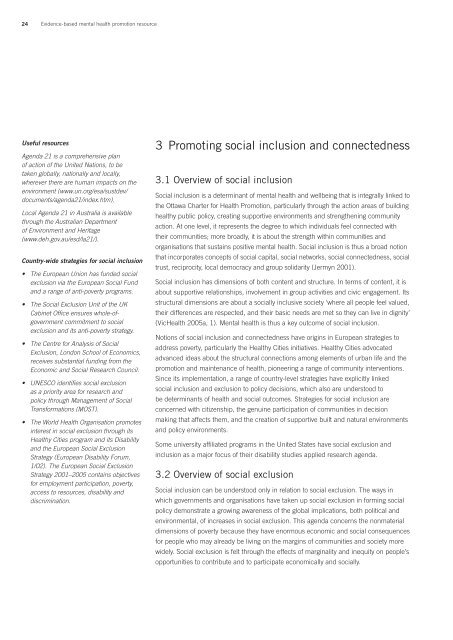Evidence-based mental health promotion resource - health.vic.gov.au
Evidence-based mental health promotion resource - health.vic.gov.au
Evidence-based mental health promotion resource - health.vic.gov.au
You also want an ePaper? Increase the reach of your titles
YUMPU automatically turns print PDFs into web optimized ePapers that Google loves.
24 <strong>Evidence</strong>-<strong>based</strong> <strong>mental</strong> <strong>health</strong> <strong>promotion</strong> <strong>resource</strong>Useful <strong>resource</strong>sAgenda 21 is a comprehensive planof action of the United Nations, to betaken globally, nationally and locally,wherever there are human impacts on theenvironment (www.un.org/esa/sustdev/documents/agenda21/index.htm).Local Agenda 21 in Australia is availablethrough the Australian Departmentof Environment and Heritage(www.deh.<strong>gov</strong>.<strong>au</strong>/esd/la21/).Country-wide strategies for social inclusion• The European Union has funded socialexclusion via the European Social Fundand a range of anti-poverty programs.• The Social Exclusion Unit of the UKCabinet Office ensures whole-of<strong>gov</strong>ernmentcommitment to socialexclusion and its anti-poverty strategy.• The Centre for Analysis of SocialExclusion, London School of Economics,receives substantial funding from theEconomic and Social Research Council.• UNESCO identifies social exclusionas a priority area for research andpolicy through Management of SocialTransformations (MOST).• The World Health Organisation promotesinterest in social exclusion through itsHealthy Cities program and its Disabilityand the European Social ExclusionStrategy (European Disability Forum,1/02). The European Social ExclusionStrategy 2001–2005 contains objectivesfor employment participation, poverty,access to <strong>resource</strong>s, disability anddiscrimination.3 Promoting social inclusion and connectedness3.1 Overview of social inclusionSocial inclusion is a determinant of <strong>mental</strong> <strong>health</strong> and wellbeing that is integrally linked tothe Ottawa Charter for Health Promotion, particularly through the action areas of building<strong>health</strong>y public policy, creating supportive environments and strengthening communityaction. At one level, it represents the degree to which individuals feel connected withtheir communities; more broadly, it is about the strength within communities andorganisations that sustains positive <strong>mental</strong> <strong>health</strong>. Social inclusion is thus a broad notionthat incorporates concepts of social capital, social networks, social connectedness, socialtrust, reciprocity, local democracy and group solidarity (Jermyn 2001).Social inclusion has dimensions of both content and structure. In terms of content, it isabout supportive relationships, involvement in group activities and ci<strong>vic</strong> engagement. Itsstructural dimensions are about a socially inclusive society ‘where all people feel valued,their differences are respected, and their basic needs are met so they can live in dignity’(VicHealth 2005a, 1). Mental <strong>health</strong> is thus a key outcome of social inclusion.Notions of social inclusion and connectedness have origins in European strategies toaddress poverty, particularly the Healthy Cities initiatives. Healthy Cities advocatedadvanced ideas about the structural connections among elements of urban life and the<strong>promotion</strong> and maintenance of <strong>health</strong>, pioneering a range of community interventions.Since its implementation, a range of country-level strategies have explicitly linkedsocial inclusion and exclusion to policy decisions, which also are understood tobe determinants of <strong>health</strong> and social outcomes. Strategies for social inclusion areconcerned with citizenship, the genuine participation of communities in decisionmaking that affects them, and the creation of supportive built and natural environmentsand policy environments.Some university affiliated programs in the United States have social exclusion andinclusion as a major focus of their disability studies applied research agenda.3.2 Overview of social exclusionSocial inclusion can be understood only in relation to social exclusion. The ways inwhich <strong>gov</strong>ernments and organisations have taken up social exclusion in forming socialpolicy demonstrate a growing awareness of the global implications, both political andenviron<strong>mental</strong>, of increases in social exclusion. This agenda concerns the nonmaterialdimensions of poverty bec<strong>au</strong>se they have enormous economic and social consequencesfor people who may already be living on the margins of communities and society morewidely. Social exclusion is felt through the effects of marginality and inequity on people’sopportunities to contribute and to participate economically and socially.



